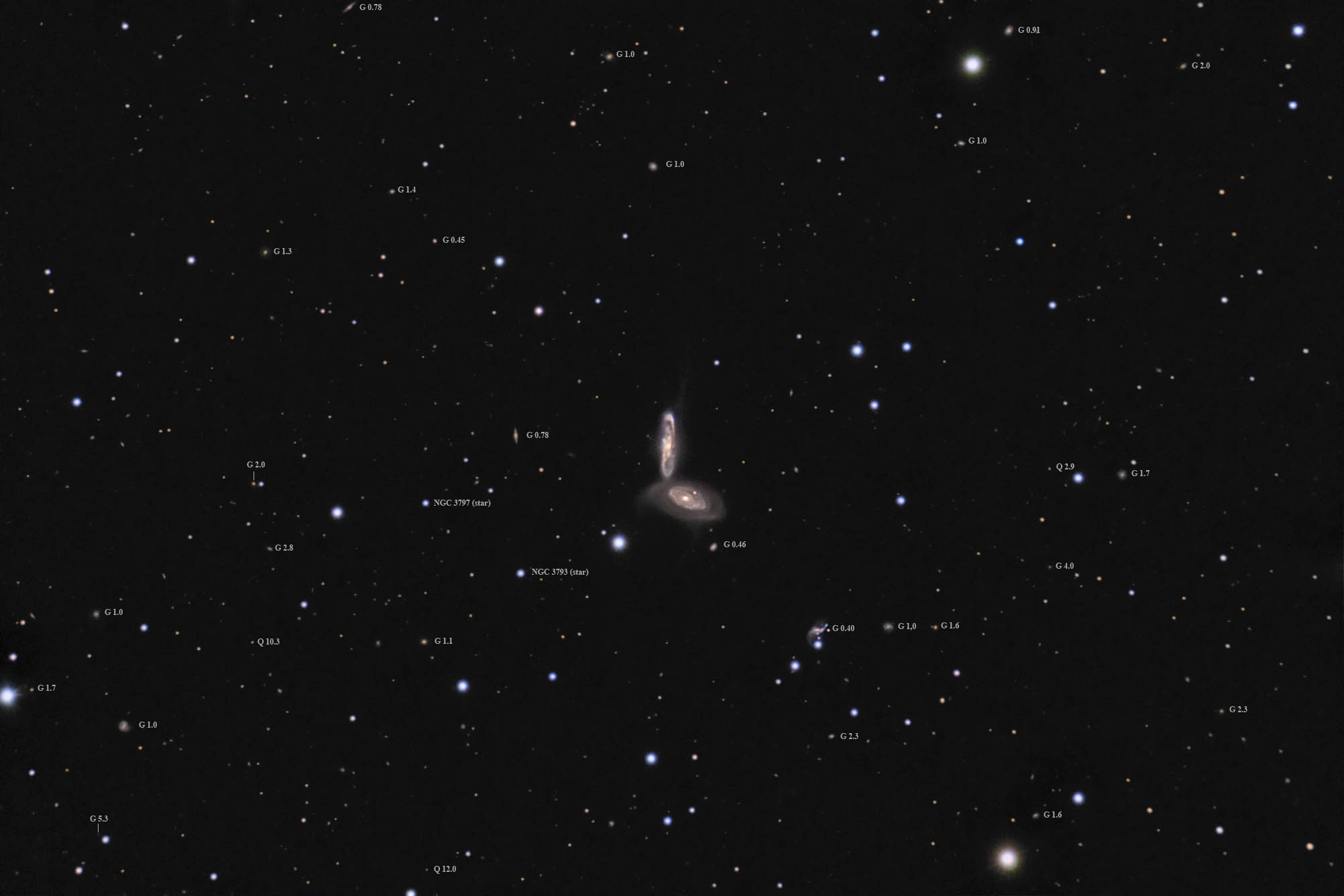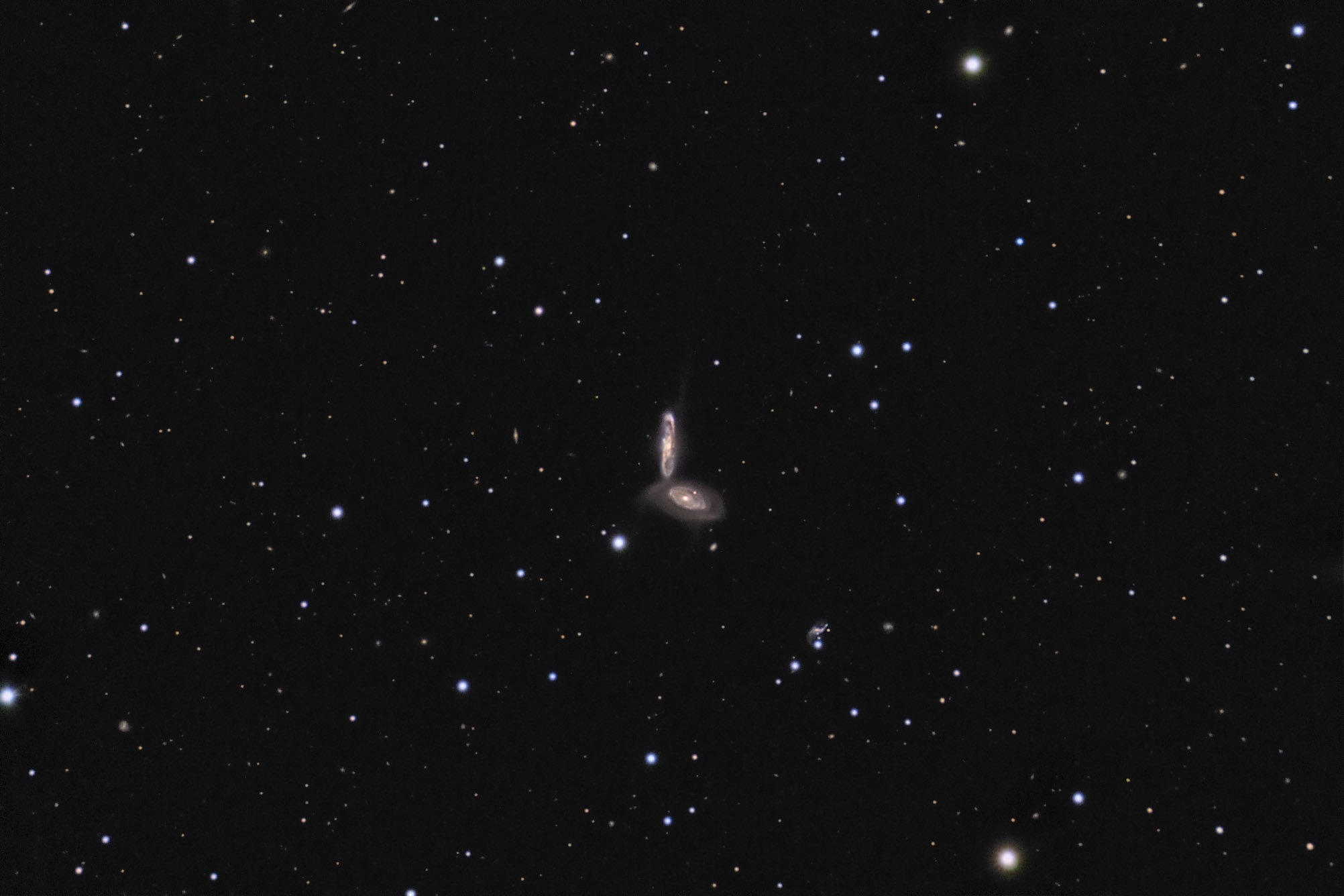Object name: ARP294Designation(s): ARP294, NGC3786, NGC3788, Accelerate to ramming speed!
Arp 294 is an interacting pair of galaxies about 135 million light-years distant in southern Ursa Major. It appears the upper one is about to ram into the lower though this isn't likely the case at all. The image did remind me of a much-criticized line in the B5 series when a spaceship Captain ordered: "Ramming speed!". Arp classified them under Group Character: Long filaments. I'd have classed it under Wind Effects but it isn't my catalog. While the northern galaxy, NGC 3788, does have a long filament that is typical of tidal interaction, the lower galaxy, NGC 3786, has two rather unusual filaments that look a bit "wind blown". They are likely tidally created, however. Arp did see these as his comment on the pair is simply; "Peculiar filaments." NGC 3786 is classified as (R')SAB(r)a pec and has an active nucleus that appears to be a Seyfert 1. NGC 3788 is classed as SAB(rs)ab pec. Both shine at 13th magnitude so should be visible in an 8" scope under dark skies. The filaments, however, may challenge even the largest scopes.
NGC 3786 was discovered by John Herschel on April 10, 1831 while he found NGC 3788 four years earlier on April 29, 1827.
The small galaxy just below NGC 3786 is SDSS J113939.20+315320.4 at 460 million light-years. The red vertical spindle galaxy east of NGC 3788 is SDSS J114002.67+315607.1 is about 780 million light-years distant.
The spiral galaxy about 5 minutes of arc southwest of Arp 294 is CGCG 157-007 about 400 million light-years away. It appears rather distorted with tidal debris. This interaction must have happened some time ago as there are no obvious nearby candidates for a partner. The "small" galaxy to its west is SDSS J113918.50+315121 at 1 billion light-years. Far too distant to be involved. Further west of it is the even "smaller" galaxy SDSS J113912.92+315120.5 at 1.6 billion light-years.
The galaxies and quasars I was able to find redshift data on at NED are shown on the annotated image. The most distant galaxy is 5.3 billion light-years distant shining at fainter than 21st magnitude so at about my limit on this image. Quasars range from just 2.9 to 12 billion light-years.
SDSS image:
http://astronomerica.awardspace.com/SDSS-27/NGC3786-8.php
The SDSS page makes reference to NGC 3793 as being CGCG 157-007. This is wrong. NGC 3793 is a single star east, not west of Arp 294. To find it on the SDSS image go from NGC 3786 to the bright red star then continue almost of the same line about the same distance to this rather bright star. It is directly below the vertical spindle of SDSS J114002.67+315607.1 mentioned above. NGC 3797 is also a star in my image but just out of the frame of the SDSS image. For a more complete discussion of this mix-up see the NGC project entry for NGC 3793. http://www.ngcicproject.org/dss/dss_n3700.asp I can't explain why the very red star in the Sloan image is white with a blue halo in my shot. SDSS uses three IR filters along with three visual band filters and it could be those colors are so strong they skew the color to red. Very bright stars cause blue halos in my filters but the star in question is spectral class G0 so a pretty white star in reality. It is GSC 2523:1968/HIP 56900 for those who want to look it up.
Arp's image:
http://ned.ipac.caltech.edu/level5/Arp/Figures/big_arp294.jpeg
14" LX200R @ f/10, L=4x10 RGB=2x10, STL-11000XM, Paramount ME Related Designation(s):1RXP J113942.8+315439, 1RXS J113941.8+315441, 2MASS J11394250+3154339, 2MASS J11394458+3155524, 2MASX J11394247+3154337, 2MASX J11394459+3155526, 2MASXi J1139425+315433, 2MASXi J1139445+315552, 2MFGC 09141, 2PBC J1139.6+3157, 2XMM J113942.5+315433, 2XMM J113944.3+315547, 2XMMp J113942.5+315433, 2XMMp J113944.4+315547, AKARI J1139443+315605, ARP 294, ARP 294 NED01, ARP 294 NED02, ARP294, CG 0118, CGCG 1137.0+3211, CGCG 1137.1+3213, CGCG 157-009, CGCG 157-010, ECO 02914, ECO 02915, FIRST J113942.5+315433, FIRST J113944.0+315551, HOLM 272, HOLM 272A, HOLM 272B, KPG 295, KPG 295A, KPG 295B, KUG 1137+321, LDCE 0825 NED003, LDCE 0825 NED004, LGG 243:[G93] 002, LGG 243:[G93] 003, LQAC 174+031 018, MCG +05-28-008, MCG +05-28-009, MRK 0744, NGC 3786, NGC 3786:[KPC2006] 1, NGC 3786:[KPC2013] N1, NGC 3788, NGC3786, NGC3788, NSA 088792, NSA 140004, NVSS J113942+315433, NVSS J113944+315556, PGC 036158, PGC 036160, RX J1139.7+3154, SDSS J113942.52+315433.7, SDSS J113944.58+315552.4, SDSS J113944.59+315552.4, SSTSL2 J113942.50+315433.9, SSTSL2 J113944.56+315552.2, SWIFT J1139.4+3156, UGC 06621, UGC 06623, UZC J113942.4+315433, UZC J113944.7+315551, VV 228, VV 228a, VV 228b, WBL 345-002, WBL 345-003, [M98j] 136, [M98j] 136 NED01, [M98j] 136 NED02, [TTL2012] 514759, [VCV2001] J113942.6+315434, [VCV2006] J113942.6+315434, [WGB2006] 113700+32110_a, [WGB2006] 113700+32110_b, | | 
